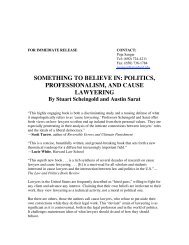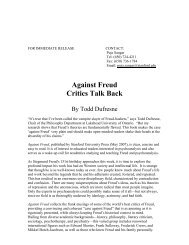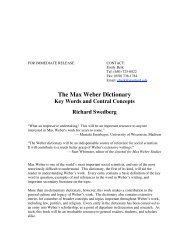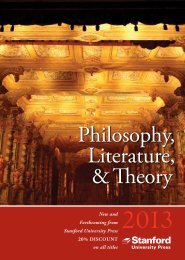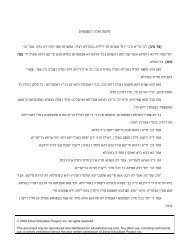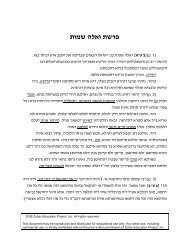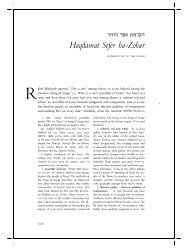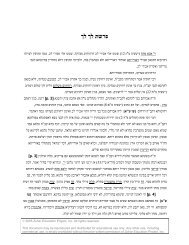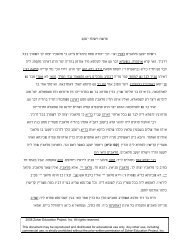Front Matter (PDF) - Stanford University Press
Front Matter (PDF) - Stanford University Press
Front Matter (PDF) - Stanford University Press
You also want an ePaper? Increase the reach of your titles
YUMPU automatically turns print PDFs into web optimized ePapers that Google loves.
seem to be rather arbitrarily placed in one Torah portion or another. 3<br />
to the three volumes is Zohar Ḥadash (New Zohar), a collection of<br />
addition<br />
that were omitted from the earliest printed Zohar editions but were<br />
materials<br />
culled from manuscript sources. Here we ®nd addenda to the Torah portions<br />
later<br />
but also partial commentaries on Ruth, Lamentations, and the Songof<br />
Another work usually considered part of the Zohar literature is Tiqqunei<br />
Songs.<br />
a kabbalistic commentary on the openingverse of Genesis that expli-<br />
Zohar,<br />
it in seventy ways. This workÐalongwith the Ra'aya Meheimna or<br />
cates<br />
Shepherd'' passages published within the Zohar itself, mostly taking<br />
``Faithful<br />
form of a commentary on the commandmentsÐis seen by modern scholars<br />
the<br />
to be the work of a slightly later kabbalist, one who wrote perhaps in the<br />
of the fourteenth century and saw himself as continuingthe<br />
openingdecades<br />
tradition.<br />
Zohar<br />
stated, the main body of the Zohar takes the form of midrash: a collection<br />
As<br />
of homiletical explications of the biblical text. The Zohar enters fully into<br />
midrashic genre, even though that form of writing was considered antiquated<br />
the<br />
in the time and place where the Zohar was composed. Its authors were<br />
learned in aggadah and used it ingeniously, often convincingly portrayingthemselves<br />
especially<br />
as ancient midrashic masters. But the anachronism of their<br />
was intentional. The Zohar is an attempt to re-create a form of discourse<br />
style<br />
would have seemed appropriate to a work originating with its chief speak-<br />
that<br />
Rabbi Shim'on son of Yoḥai and those of his circle, who lived in the land<br />
ers,<br />
Israel eleven hundred years earlier. In fact, this medieval midrash is based<br />
of<br />
a thorough knowledge of the entire earlier Jewish tradition, including<br />
on<br />
philosophical, and esoteric works. Its purpose, as will quickly become<br />
rabbinic,<br />
to the reader, goes far beyond that of the ancient midrashic model. The<br />
clear<br />
seeks nothingless than to place the kabbalistic tradition, as it had<br />
Zohar<br />
over the precedingcenturies, into the mouths of these much-revered<br />
developed<br />
of antiquity and to use them as its mouthpiece for showing the reader<br />
sages<br />
the entire Torah is alive with kabbalistic secrets and veiled references to<br />
that<br />
``mystery of faith'' as the kabbalists taught it. In this sense, the Zohar may<br />
the<br />
seen as an attempt to create a new midrash or, as one scholar has put it, a<br />
be<br />
of the midrashic art in the Middle Ages.<br />
renaissance<br />
old midrashic homilies were often preceded by a series of ``Openings,''<br />
The<br />
proems in which the homilist would demonstrate his skill, pick-<br />
introductory<br />
way through a series of biblical associations eventually leadingup to<br />
inghis<br />
subject at hand. The Zohar too uses such ``Openings,'' but with a very dif-<br />
the<br />
purpose in mind. Here the preacher wants to ``open'' the scriptural verse<br />
ferent<br />
remove its outer shell, and ®nd its secret meaning. In this way, the verse<br />
itself,<br />
For a discussion of how these special sections of the Zohar have been handled in<br />
3.<br />
translation, see the Translator's Introduction.<br />
this<br />
Introduction<br />
An<br />
lvii<br />
itself may serve as an openingor a gateway into the ``upper'' world for the one



